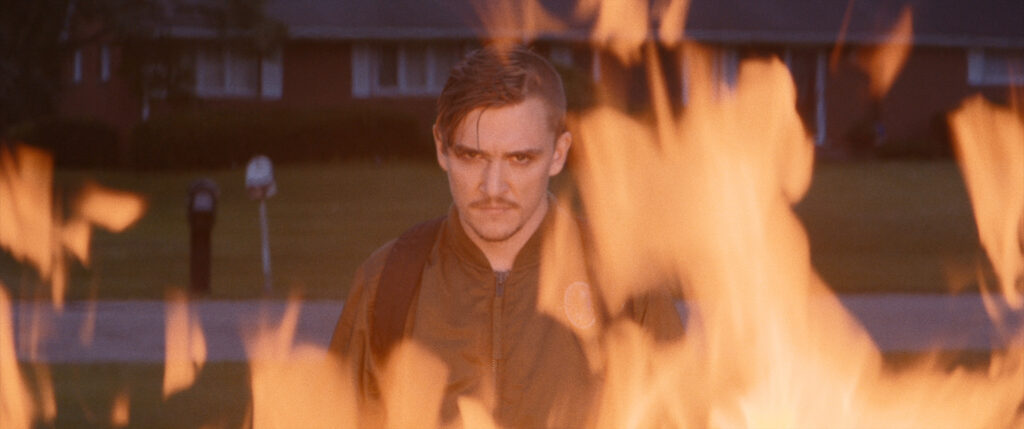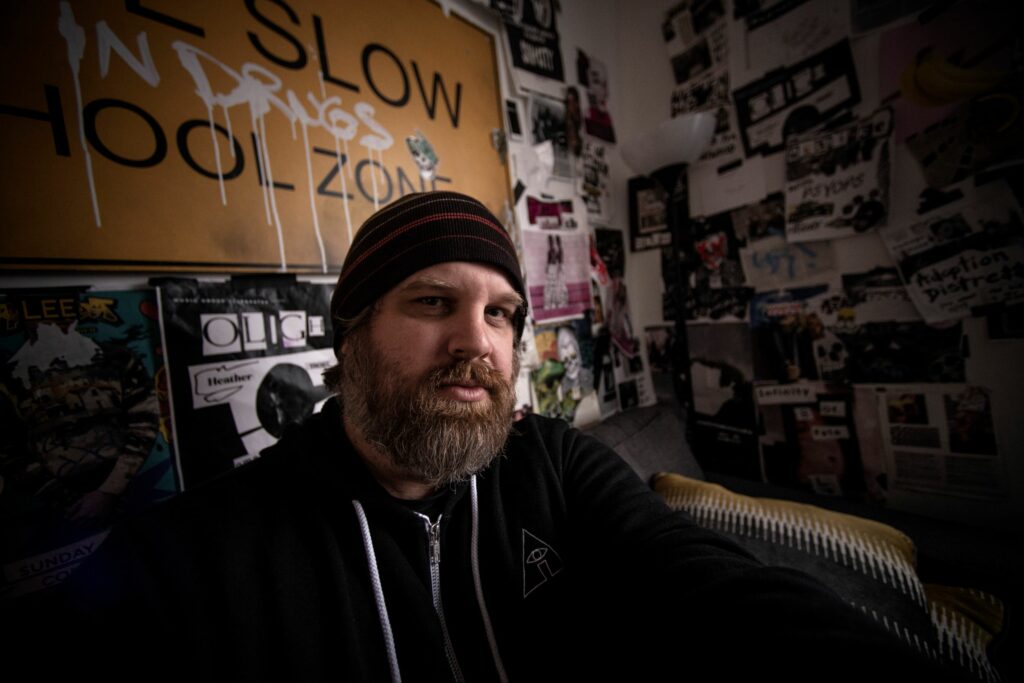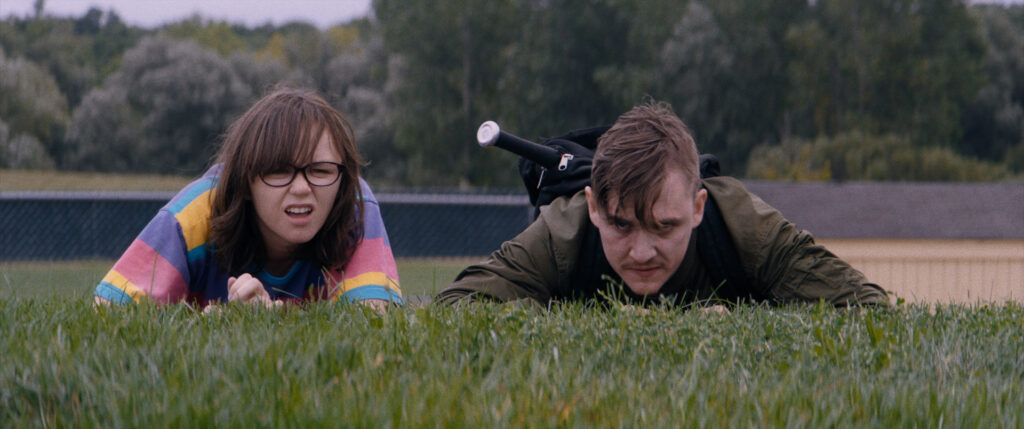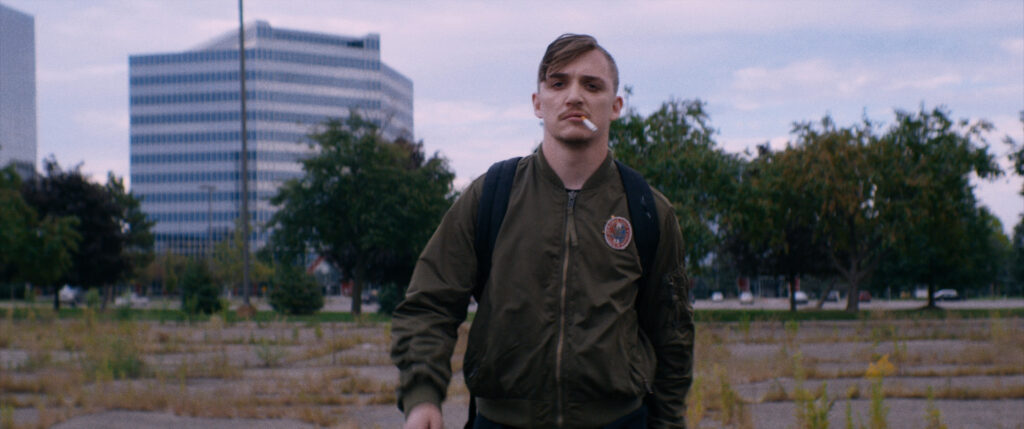Writer-director Adam Rehmeier sat down with Outtake to discuss the making of his latest film, Dinner in America, a fiery, punk-infused satire of Midwestern suburbia.
The film explores the friendship and blossoming romance between Simon (Kyle Gallner, American Sniper, Jennifer’s Body), a rebellious musician with a penchant for pyromania and Patty (Emily Skeggs, The Miseducation of Cameron Post), a socially awkward pet-shop worker with a habit of sending nude polaroids to her celebrity crush.
But Dinner in America is not your typical love story. Rehmeier takes all the ingredients of a classic coming-of-age film and douses them with wickedly dark humour in his electrifying homage to punk anarchism.

Tell me a bit about your background and how you got into filmmaking?
Adam Rehmeier: Well, my background has been in a wide range of stuff – pretty much every aspect of filmmaking. I started in camera and editing. I really just started making things when I didn’t really know how to make things – doing all the aspects of it, because I was interested.
Before even shooting and stuff like that, I was a musician. I played in bands and stuff growing up as a kid, which was fun. And when I was doing that, I was always making little videos and stuff that went with the music and just experimenting with different mediums. So take that, plus 20 years of working in the business as a camera operator, a DP, an editor, director, writer… I’ve done soundtrack work and stuff, too. I’ve had a… I wouldn’t say a strange career, but it’s been all over the place.
The music in the film is great – did you always intend to feature it heavily?
Adam Rehmeier: I think that even if it’s just subconsciously, yes. Everything for me – how I write, how I edit – is all very rhythmical. The thing that surprised me most thematically about Dinner in America– and you’re maybe not conscious of when you’re working – is that it’s very much like a punk song. It’s very abrasive but there’s a message underneath it.
The way I think Dinner In America is designed, it does something where it’s really abrasive when you first see it but it has that deeper and more sensitive message.

You wrote and directed the film – in terms of the writing, what was the inspiration? What prompted you to write it?
Adam Rehmeier: I have a kind of garden with my scripts; like a garden mentality. There’s just a lot of maturation over long periods of time. It starts with a seed or a kernel or an idea, and you just keep watering it. For this particular film, it was like 2006 and I was on a walk where my parents live, it had snowed, and the trucks had come and ploughed and salted the road. And the sound and the rhythm of my boots when I was walking, brought Simon to my head.
I went back to my parents’ house and wrote out the first 10 pages of what would become the film. Like Simon in this lab, working and then going home with the first family. You think he’s going to meet this girl and there’s going to be some kind of relationship but then it derails, and then he’s free.
That whole sequence was written just from feeling this cadence and this rhythm as I was walking. The character just popped in my head and I had to go back and frantically get it out. And then it sat untouched for many years. The project was called Kicks for a while, about this musician who was selling his body to science to pay for his albums.
It was dead in the water and I didn’t know what to do with it. And then maybe 2009, or 2010… when I have writer’s block I tend to sketch random characters. I’ve got this nuclear Midwestern American family that I’m just riffing off – actually the first scene with the family all around the table together, that was the first thing I wrote for that family, pretty much as it is. That was a sketch of this family that was called “Dinner in America”.
So there were two projects: Kicks in one folder and Dinner in America in another – and they sat relatively close to each other for a few years on different hard drives and computers and stuff. At one point, I just decided, wouldn’t it be cool if the character from Kicks crossed over and affected this family in some way? And there was then there was life to that. And I thought, “well, that would be a cooler movie than either of these two things separately.”

So you know, I didn’t set out to write Dinner in America in 2006. But in 2013, there’s this finished script that combined elements of one thing with another that I tended to over time, and just kept tending to it.
If there was some advice I would give regarding the industry in general, it’s that you should have 7, 8, 9 ,10 things going at once, because you’re just hoping one of them is going to work out in the next 18 months.
I want to build a catalogue of really specific films that resonate deeply with me. I don’t see a point in doing anything other than what I really care about. I can pick up work on other things if I want to do that, if I want to just work. But if it’s going to be my own film that I’m going to sink 5-7 years of development into, then I want to love it.
It’s important to make work that you can be proud of.
Adam Rehmeier: Yeah, and that takes time, and time is not valued in the industry. There’s projects that just can’t get off the ground sometimes but I believe that each project takes the amount of time it needs to take. I’ve got a TV project that I’ve been working on for over 10 years.
You put a lot of hours, time, and energy into each project. They’re all like babies. And I have three boys, too.
What was harder, raising the kids or writing the scripts?
Adam Rehmeier: The children. But both those things work together to push and challenge me, and take me out of my comfort zone.
But it’s so complicated, especially when they’re young – and my kids are all very young – they’re eight, six and four. It’s a lot, but there’s a lot to pull from, too. Those things work together: family dynamics, daily rhythms, it’s all one thing. I use that to my advantage.

Do you find inspiration from them?
Adam Rehmeier: Yeah, of course. Big time. I have another project and they’re dying to be in it. And they will get to be in it, but I’m feeding them fake lines all the time and they’re practising at dinner and stuff. So it’s cute.
They got to come to set one day. They can get a little rambunctious, so you just want to keep the energy right. I think they saw a couple things get shot, some of the dinner stuff with the family. They brought doughnuts for the crew, ones that said Dinner in America. Kyle [Gallner] has kids really close in age to mine, too. He has two boys. They came out last year and we got the families all together.
What was the casting process like?
Adam Rehmeier: Kyle, it was his Facebook picture. I liked him. I really believe that I can look at a photo of somebody and want to work with them based on that. A good photographer gets the essence of that person.
He had this tintype, and that was the photo the casting director had for Kyle. I don’t know if he was using it as a headshot. It was gorgeous, it just looked beautiful. But when I saw that it was sort of like James Dean, kind of bad boy but with a sensitivity and vulnerability. Just from the picture, I would have worked with him.
One of the producers had his email and sent him the script, like “hey, you’ve got to read this Dinner in America script.” But he was on some big TV show at the time and didn’t check it out, then he had his kids.
We moved on and took it to some other people, and then my DP found himself working with Kyle in Romania. And he said, “hey, I’m shooting this movie in the states that just fell apart, I don’t think they have a lead, you should check it out. It’s called Dinner in America.” And Kyle goes, “I’ve heard of that. I know that movie. I have that script.” He went back to his email from three years before and finally opened up the fucking script!
As soon as he’d read it though, he wanted to do it. It was 4am for him in Romania and I’m getting these messages like, “Kyle wants to talk to you about it.” I’m like “Kyle Gallner? What the fuck is happening right now? All right, let’s talk.”
We had the meeting the very next day and I was like, “you little shit.” [laughs] I was like, “dude, that was like almost 1000 days. It took 1000 days to get a read out of you.”

But you know, it’s a timing thing. Yes, it took six years to get the film from when I wrote it to premiere. It’s long. It’s exhausting. But that’s life. That’s how it works. It was worth it.
What was it like being a writer/director and editor – must have been a lot of work?
Adam Rehmeier: Oh yeah, I did the whole film, front to back, everything. It’s an enormous amount of work. That was budgetary and because I can edit. For me though, it deepened the whole thing because you’re now controlling every aspect of it. You live or die by your own decisions. It’s like the Samurai code at that point.
This film felt incredibly unique – how would you describe it?
Adam Rehmeier: It’s deeply personal in a lot of ways. Any time you are going to edit the film yourself, that’s a lot of pressure. For me, I shoot and edit, I have for 20 years. So, when I’m shooting, I’m also cutting; it’s the same thing. I don’t ever walk away from a scene if rhythmically I know I don’t have all the puzzle pieces.
So yes, it’s daunting, but it’s the kind of pressure that I think you need to push yourself with things. I’m a big fan of letting the film tell you what it needs. You need to experience it, and then pause and take a break. And then you need to re-examine it and pick it apart. The last three or four passes for me are all microscopic.
Were you editing it every night after shooting?
Adam Rehmeier: No, I wasn’t even working on the film until like two weeks after we shot. I took a pause after production and I just went into grind mode to get it done. I had my first cut done in a couple months and then we just kept whittling it down. My first cut was two hours and 19 minutes and it’s an hour 46 now.
Am I right in thinking that Ben Stiller produced the film – when did he come on board and what was it like working with him?
Adam Rehmeier: Yes, you’re correct. Both Ben and Nicky Weinstock at Red Hour came on in 2016. I look at them like shepherds for the project. It was an amazing experience.
I’m trying to frame it in a way without saying spirit animals, you know? [laughs] They helped get us access to cast and were helpful in so many ways with their expertise and everything; that’s worth its weight in gold to a small film.

How did you meet them?
Adam Rehmeier: One of our producers, Ross Putman, had given the script to their exec, who had passed it on to Nicky and he immediately responded to it. The next thing I know, I was in New York meeting with all of them.
Ben was really great. He’d actually seen my previous film The Bunny Game. That was wild. We all spoke the same language, too. The thing about Ben is he really understands all aspects of filmmaking, he’s a very accomplished director and actor. And they are supportive of your vision and trust that you can execute it.
How long was the shoot?
Adam Rehmeier: 25 days. For an indie, that’s pretty long. But Dinner in America has like 65 locations and above 70 speaking parts. The most stable thing we had was a week at the house that was Patty’s parents’ house.
Who would you cite as inspirations in your work?
Adam Rehmeier: When I was 18, I saw this collection of Maya Deren shorts. It was like Meshes of the Afternoon and At Land, and I think Ritual in Transfigured Time. And I didn’t know that films could do that. Around the same time, I saw Eraserhead by David Lynch, and I didn’t know that films could do that either!
I grew up in Nebraska. I didn’t have access to art film types of stuff. And then when I finally did, when I started to go to these types of screenings, my mind was opened in a way that I could think about the craft differently.
There’s a song that Patty sings over the end credits, can you tell me more about that?
Adam Rehmeier: We call it Watermelon. Emily and I wrote the song together and performed it together. She had a bunch of lyrics already and I wrote the musical part of it.
We did it right before we shot the film. We did it in our little rehearsal period block, so that was cool. And Kyle performed all his music, too. We brought in a punk band I had worked with from Windsor, Canada called Disco Assault. And Kyle did all the music with them, and it turned out great. So yeah, we’re trying to get something on vinyl for the UK. I love records. So I wouldn’t do it any other way.
What’s next for you?
Adam Rehmeier: One of the garden projects, pick one, any one! I’ve got a project called Save a Bullet For Me. That’s a really batshit crazy Western that I’ve been putting together. It’s a hardcore genre film, just a tornado of blood and guts, not dialogue driven. That’s one of the seven or eight. They’re all just different babies, you know?
Dinner in America is streaming on Arrow and available to buy or rent on all digital platforms in the UK from 1st June.
